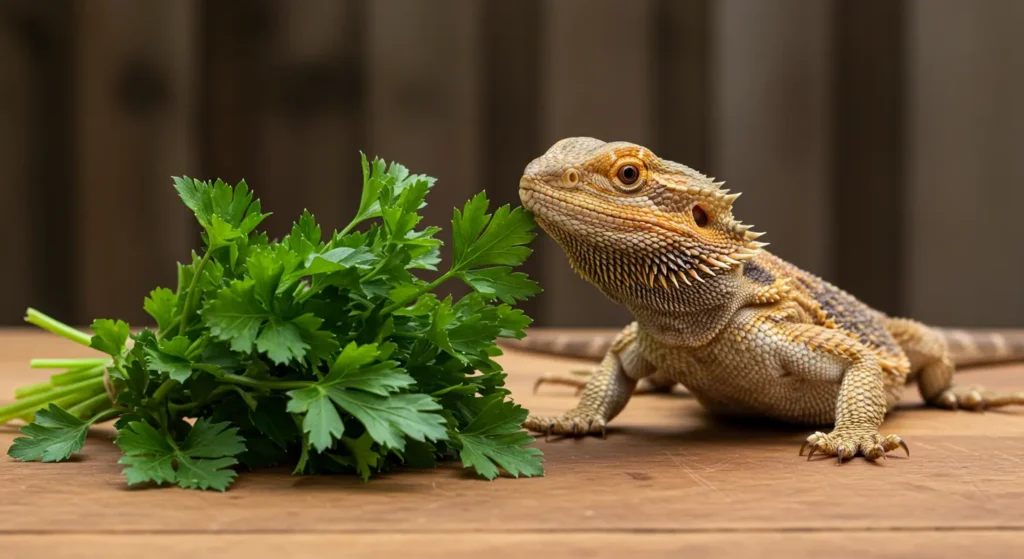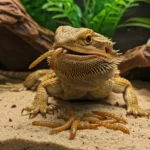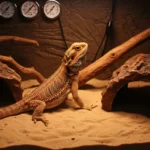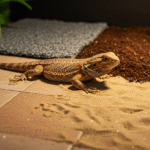can bearded dragons eat parsley? It’s a question many reptile owners ask when trying to diversify their pet’s diet with fresh, leafy greens. Parsley is easy to find, packed with nutrients, and often used in human meals—but does that make it safe for your bearded dragon?
Understanding whether parsley is beneficial or potentially harmful is key to keeping your reptile healthy. In this guide, we’ll answer can bearded dragons eat parsley in detail—exploring its nutritional value, the risks of overfeeding, and how to serve it properly as part of a balanced bearded dragon diet.
can bearded dragons eat parsley Safely?
Parsley might seem like a harmless herb, but can bearded dragons eat parsley? Before adding it to your reptile’s diet, it’s important to understand which parts are safe, how much to serve, and whether it poses any hidden risks.
Why Do Reptile Owners Choose Parsley for Bearded Dragons?
Parsley is a popular herb among reptile owners due to its availability, affordability, and fresh scent. It’s easy to find in any grocery store and often recommended as a treat or occasional leafy green. Many owners assume that since parsley is high in vitamins like A, C, and K, it’s a healthy option for their bearded dragons. Its bright green color and strong aroma also tend to appeal to reptiles, especially those that are picky eaters. However, while parsley has some nutritional benefits, that doesn’t automatically make it ideal for regular feeding. In fact, parsley contains compounds that can affect calcium absorption. That’s why it’s important to look beyond popularity and focus on how safe and appropriate parsley really is for your pet’s long-term health.
Is Parsley Toxic or Non-Toxic for Bearded Dragons?
Parsley is non-toxic to bearded dragons when fed in moderation. It does not contain any compounds that are immediately poisonous or dangerous in small amounts. However, parsley is high in oxalates—natural compounds that can bind to calcium and prevent its absorption. This can lead to a calcium deficiency, which increases the risk of metabolic bone disease (MBD) over time. While parsley won’t harm your bearded dragon in a single serving, regular or excessive feeding could contribute to long-term health issues. That’s why most reptile experts recommend offering parsley only as an occasional treat, not a staple part of the diet. It’s important to understand that “non-toxic” doesn’t always mean “safe for frequent feeding.”
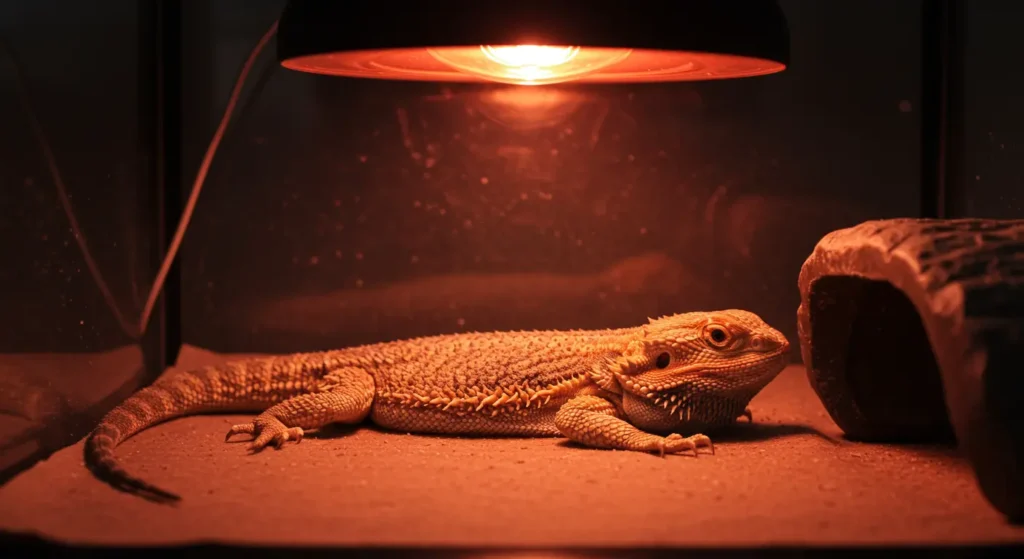
Which Parts of Parsley can bearded dragons eat parsley?
When feeding parsley to bearded dragons, only the leaves and tender stems should be used. The leafy part contains most of the nutrients and is easier for your reptile to digest. The thin, green stems attached to the leaves are also generally safe in small amounts. However, avoid giving the thicker lower stems or roots, as they can be tough to chew and may cause digestive discomfort. Roots also tend to accumulate soil and pesticides, making them a higher risk if not thoroughly cleaned. Always wash parsley well before serving and remove any hard or fibrous parts to reduce choking or impaction risks. For the safest option, offer chopped parsley leaves in small amounts mixed with other calcium-rich greens.
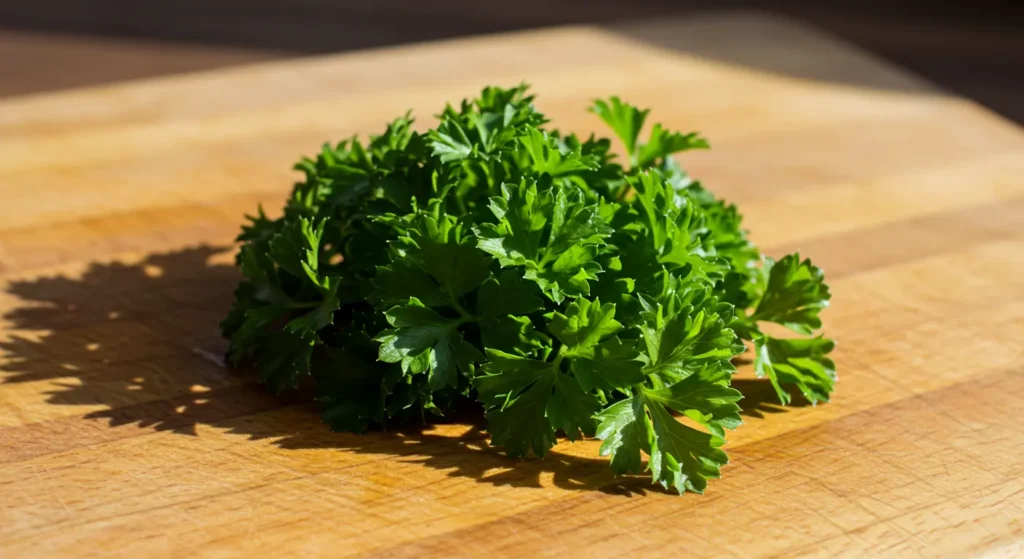
How Much Parsley Can Bearded Dragons Eat at a Time?
Bearded dragons should only eat a small amount of parsley occasionally, not every day. A portion of 2–3 chopped leaves once every one to two weeks is usually considered safe. Feeding more than this can lead to issues due to parsley’s high oxalate content, which interferes with calcium absorption. Parsley should never make up the majority of your bearded dragon’s salad or veggie mix. Instead, it should be treated as a garnish or a flavor enhancer. You can mix a few pieces into a bowl of calcium-rich greens like collard, mustard, or dandelion greens. By limiting parsley to an occasional role in the diet, you can give your bearded dragon variety without putting its health at risk.
Understanding Parsley’s Nutritional Value for Reptiles
Parsley is often praised for its vitamin content, but its nutritional profile isn’t entirely reptile-friendly. To determine if it’s truly beneficial for bearded dragons, we need to look closely at its vitamins, minerals, calcium-to-phosphorus ratio, and oxalate levels.
Key Vitamins and Minerals in Fresh Parsley for Reptiles
Fresh parsley is rich in essential nutrients, which is why it’s often considered a healthy herb. It contains high levels of vitamin A, vitamin C, and vitamin K, all of which support immune function, vision, and blood health. These vitamins can benefit a bearded dragon’s overall health when given in moderation. Parsley also offers trace amounts of iron, potassium, magnesium, and folate, adding variety to your bearded dragon’s diet. However, too much vitamin A, especially when combined with other high-A foods, may lead to health concerns. While parsley is nutrient-dense, it should only play a minor role in your reptile’s diet and be balanced with calcium-rich greens.
Why the Calcium to Phosphorus Ratio Matters in a Bearded Dragon Diet
A proper calcium to phosphorus ratio is critical in any bearded dragon’s diet. The ideal ratio is 2:1 in favor of calcium. Parsley contains more phosphorus than calcium, which disrupts this balance. When phosphorus levels are too high, they interfere with calcium absorption and reduce its effectiveness. This can negatively impact bone strength and overall skeletal health. Feeding parsley occasionally and pairing it with high-calcium foods such as collard greens helps reduce this risk. Paying attention to this ratio supports stronger bones and better long-term health.
How Oxalates in Parsley Affect Bearded Dragons
Parsley contains moderate to high levels of oxalates, which are compounds found in many leafy greens. Oxalates bind with calcium during digestion, making it harder for reptiles to absorb this important mineral. A diet with too many oxalates may reduce calcium levels in the body, even if calcium is present in other foods. This can affect bone density and mobility. To reduce this risk, parsley should only be offered in small amounts. Mixing it with low-oxalate greens like turnip or mustard greens ensures variety without sacrificing calcium absorption.
Parsley’s Hydration and Fiber Content for Reptile Health
Parsley has a high water content, making it useful for supporting hydration. This can be especially helpful when your bearded dragon is not drinking much from a bowl or during warmer conditions. In addition to moisture, parsley also contains a small amount of dietary fiber. Fiber helps promote healthy digestion and regular bowel movements. While the water and fiber content offer benefits, too much can cause soft stools. For this reason, parsley should be used as a supplement rather than a dietary staple. Combining it with fibrous greens can help maintain digestive balance.
Risks of Feeding Parsley to Bearded Dragons
Feeding parsley to bearded dragons might seem harmless, but it comes with certain nutritional concerns. To protect your reptile’s health, it’s important to understand how parsley can affect calcium levels, digestion, and overall well-being when not fed properly.
Can Excess Parsley Cause Calcium Deficiency or MBD in Bearded Dragons?
Yes, feeding too much parsley can contribute to calcium deficiency in bearded dragons, which may lead to metabolic bone disease (MBD). Parsley is high in oxalates, compounds that bind to calcium and make it harder for the body to absorb. Even if your dragon’s diet includes calcium-rich foods or supplements, excessive parsley can block that absorption. This imbalance weakens bones and may cause deformities, lethargy, or difficulty moving. MBD is one of the most common health issues seen in captive reptiles and is often linked to poor diet. While parsley may offer some nutritional benefits, its high oxalate content makes it a risky choice if fed frequently. To prevent this, limit parsley to an occasional treat and always pair it with foods that are low in oxalates and high in bioavailable calcium.
Oxalic Acid Content and Its Effect on Calcium Absorption
Parsley contains a significant amount of oxalic acid, a natural substance found in many plants. In reptiles, oxalic acid is concerning because it binds to calcium during digestion. Once bound, calcium cannot be properly absorbed into the bloodstream. This prevents the mineral from supporting bone structure and other vital functions. A diet high in oxalic acid can silently lead to calcium depletion, even if the dragon appears to eat well. Poor calcium absorption increases the risk of metabolic bone disease and weakens your pet’s skeletal health. For this reason, parsley should be used sparingly and always in combination with calcium-rich greens. Avoid feeding other high-oxalate foods on the same day to reduce cumulative risk.
Digestive Problems from Too Much Parsley in a Bearded Dragon’s Diet
Although parsley contains fiber and water, too much of it can upset a bearded dragon’s digestive balance. Overfeeding watery herbs like parsley may lead to loose stools or diarrhea, especially when not combined with more fibrous foods. This is because excessive moisture in the digestive system can disrupt normal stool formation. Diarrhea may seem minor but can cause dehydration and impact nutrient absorption. In some cases, it may also be a sign of dietary stress or irritation from oxalates. It’s important to monitor your bearded dragon’s waste after introducing any new food. If soft stools occur, reduce or eliminate parsley and offer more balanced greens. Always serve small, properly washed portions and observe how your reptile reacts.
Should Baby Bearded Dragons Eat Parsley?
Baby bearded dragons have more sensitive digestive systems and higher calcium needs than adults. For this reason, parsley is generally not recommended for young dragons. The high oxalate content can interfere with calcium absorption at a stage when proper bone growth is critical. Baby dragons also require more frequent feeding and faster nutrient uptake. Offering parsley to a juvenile may limit calcium availability and lead to poor development. Additionally, strong-flavored herbs like parsley may irritate their stomach or discourage them from eating more suitable greens. If you want to introduce variety, focus on safe, calcium-rich options such as collard greens, dandelion greens, or squash. Parsley can be introduced later, in small amounts, once your dragon is fully grown and has a more stable digestive system.
How to Feed Parsley to Your Bearded Dragon Properly
Feeding parsley the right way can help minimize risks while still adding variety to your bearded dragon’s diet. To do this safely, you need to know how to prepare, portion, and combine parsley with other greens for a balanced meal.
How to Wash and Prepare Parsley Safely
Before offering parsley to your bearded dragon, it’s essential to wash it thoroughly. Fresh herbs may carry pesticides, dirt, or bacteria that could harm your reptile. Always rinse parsley under cool running water, gently rubbing the leaves to remove residues. If it’s not organic, soaking it in a water-and-baking-soda solution for a few minutes can help remove chemicals. After rinsing, pat the parsley dry with a clean towel or allow it to air dry. Chop the leaves and tender stems into small, manageable pieces to prevent choking. Avoid feeding thick stems or roots, as they are harder to digest and offer little nutritional value. Preparing parsley correctly reduces the risk of contamination and makes it easier for your dragon to chew and digest safely.
H3: Serving Size: How Often Should Parsley Be Offered?
Parsley should be treated as an occasional treat in your bearded dragon’s diet—not a daily staple. A safe portion is a few chopped leaves, mixed with other greens once every one to two weeks. This limited frequency helps reduce the intake of oxalates and prevents interference with calcium absorption. Offering parsley too often can lead to imbalances in the diet, especially when paired with other high-oxalate foods. Younger dragons, in particular, should avoid regular servings due to their higher calcium needs. If you’re rotating different greens throughout the week, parsley can be added once as a flavor boost. Sticking to small portions and infrequent servings allows you to give your dragon variety without compromising its nutritional needs.
Fresh vs. Dried Parsley: Which Is Better for Beardies
Fresh parsley is generally better than dried parsley for bearded dragons. It retains more water, making it a good hydration aid, especially during warmer seasons. The nutrient profile is more complete in fresh leaves, and they are easier for reptiles to digest. In contrast, dried parsley has a more concentrated flavor and lacks the moisture content that supports hydration. Some dried versions may also include added preservatives or flavor enhancers, depending on the brand. Additionally, dried herbs are harder to chew and may increase the risk of impaction if fed in large amounts. If dried parsley must be used, it should be additive-free and served only in very small quantities. For best results, stick to fresh, clean parsley and offer it in moderation.
Mixing Parsley with Other Safe Greens
To reduce health risks, parsley should always be mixed with calcium-rich, low-oxalate greens. This balances its nutritional impact and limits the effects of its high oxalate content. Great options to mix with parsley include collard greens, mustard greens, dandelion greens, and escarole. These greens offer better calcium-to-phosphorus ratios and help offset the deficiencies in parsley. Chopping and blending them together makes the salad more balanced and appealing to your bearded dragon. You can also rotate greens weekly to ensure dietary variety. Avoid mixing parsley with other high-oxalate options like spinach or beet greens. Combining parsley with the right vegetables ensures your bearded dragon gets both flavor and nutrition without compromising its health.
Alternative Herbs and Greens for a Balanced Diet
While parsley can be offered occasionally, it shouldn’t be a regular part of your bearded dragon’s diet. To keep your reptile healthy, it’s important to rotate in safer, more nutritious herbs and greens that provide better calcium balance and fewer risks.
Best Herbs Besides Parsley for Bearded Dragons
While parsley can be used occasionally, several other herbs are safer and more beneficial for regular feeding. Cilantro (coriander) is a favorite among many bearded dragons. It’s aromatic, easy to digest, and contains low oxalates. Basil is another excellent choice. It’s flavorful, rich in antioxidants, and gentle on the digestive system. Mint may be offered in small quantities as a refreshing herb, though some dragons may be sensitive to its strong scent. These herbs provide variety without the same calcium-binding risks found in parsley. When using herbs, always introduce them gradually and observe how your beardie responds. Chop them finely and mix them with greens to enhance taste and stimulate appetite. Fresh herbs should be rotated and not relied on as the main component of any meal. This helps prevent overexposure to any one compound and keeps meals balanced.
Greens That Provide a Better Calcium Balance
The best greens for bearded dragons are those that offer a strong calcium-to-phosphorus ratio and low levels of oxalates. Collard greens are one of the top choices—they’re rich in calcium and fiber while being easy to digest. Dandelion greens are another excellent option, offering a good nutrient profile and natural appetite appeal. Mustard greens and turnip greens also rank high in calcium and provide a mild taste most dragons enjoy. These leafy vegetables support strong bone development and reduce the risk of metabolic bone disease. Avoid over-reliance on greens with poor calcium ratios like spinach or swiss chard. Mixing 2–3 of these calcium-rich greens throughout the week gives your dragon a balanced, safe, and varied diet. Always wash greens thoroughly and chop them into manageable pieces before serving.
Unsafe Herbs You Should Avoid Completely
Not all herbs are safe for bearded dragons. Some can cause digestive issues, toxic reactions, or interfere with calcium absorption. Chives and onion greens are highly toxic and should never be fed. Garlic is also unsafe due to its strong compounds, which can be irritating to a reptile’s system. Oregano and sage, while used in small amounts in some herb mixes, are generally too strong and can upset your dragon’s stomach. Rosemary and thyme are high in essential oils that can be harsh on a reptile’s digestive system. When in doubt, avoid any herb that has a strong smell or is known for its medicinal potency in humans. Stick with safe, mild herbs and research each one before offering it. If you’re unsure, consult with a reptile vet or herpetologist before feeding a new plant.
Creating a Weekly Feeding Rotation for Your Beardie
A feeding rotation helps keep your bearded dragon’s diet balanced and reduces the risk of overfeeding harmful compounds. Start by choosing a few core greens such as collard, dandelion, and mustard greens. Rotate them across 3–4 days, mixing in occasional herbs like cilantro or basil for flavor and variety. On one day each week, you can add a small amount of parsley or another treat-level herb. Avoid offering the same green every day, as this can lead to nutrient imbalances over time. By changing up the greens regularly, you keep meals interesting and ensure your dragon gets a broad spectrum of nutrients. Keep a simple chart or feeding log to track what you’ve offered each week. This makes it easier to manage variety and stay consistent with portion control.
Conclusion
So, can bearded dragons eat parsley? Yes—but only in small, occasional amounts. While parsley offers some beneficial vitamins, its high oxalate content and poor calcium-to-phosphorus ratio make it unsuitable as a regular part of your bearded dragon’s diet. When fed properly, and alongside safer, calcium-rich greens, parsley can add variety without harming your reptile’s health.
The key is moderation, variety, and balance. Always wash and prepare herbs carefully, monitor your beardie’s digestion, and rotate their greens weekly. By understanding the nutritional risks and benefits, you can confidently offer parsley as an occasional treat—while keeping your bearded dragon healthy, happy, and well-fed.

